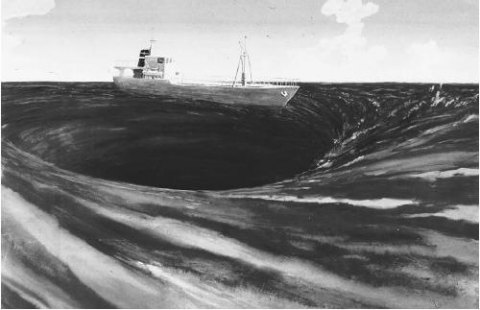
Dating back at least to the 1940's a number of ships, yachts and aircraft have “mysteriously” disappeared in a triangular section of the North Atlantic generally described as lying between Miami, Bermuda and Puerto Rico (although some of the alleged disappearances occurred as far afield as the Azores and the Gulf of Mexico off the Texas/Louisiana coast.) In 1974, two books were published, The Bermuda Triangle by Charles Berlitz and The Devil's Triangle by Richard Winer. Numerous vessels and aircraft mentioned in both books are said to have suddenly vanished without any logical explanation. Both books offer not-so-logical explanations such as abduction by space aliens.
Then in 1975, a research librarian at Arizona State University named Lawrence David Kusche wrote a book called The Bermuda Triangle Mystery: Solved in which he took each incident one at a time and laid out all the known facts surrounding them. In every case there was at least one unreported factor such as severe weather which could easily account for the disappearance. But what fun is that? Who would you rather share a lonely graveyard watch in the Gulf-Stream on a moonless night with: a great storyteller like Charles Berlitz or a scientific know-it-all who likes to rain on the parade?
Sailors as a rule are known for occasionally stretching the truth in order to spin a good yarn. In fact it's been said that the only difference between a sea story and a fairy tale is that a fairy tale always starts with “Once upon a time...” and a sea story starts with “Now this ain't no sh*t!” But I personally have never been inclined to stray from the facts. In all the passages I've made under sail in the Atlantic, up and down the southeast coast and through the Bahamas and Caribbean, I've had a few scary times, but the element of fear was always clearly from explicable causes such as weather and/or gear failure.
Always. Well... except for one time when I was at least temporarily mystified.
It happened about ten years ago when my friend Frank and I were sailing the old schooner Windfall from Ocracoke down to South Florida for the winter charter season. We had left the Cape Fear River and were bound off shore to St. Augustine, a trip that usually takes about forty-eight hours in favorable conditions. We were several miles off the coast of South Carolina. It was about two or three in the morning with stars occasionally appearing through scattered clouds. No moon. We had been taking two-hour watches with one man at the wheel while the other snoozed in a sleeping bag on deck where he could be summoned to duty on short notice if needed. It was nearing the end of my turn at the wheel. Frank was asleep. I was getting a little punchy from steering by the dimly lit compass on the rolling three to four foot seas. Suddenly, off the starboard bow I saw the flash of a white light down between the waves. It was so low to the water that I immediately judged it to be a hand-held flashlight on a very small boat quite close at hand. I snatched up the Q-beam (powerful spotlight), switched it on and scanned the area. I fully expected to see some castaways in a life raft but saw nothing but waves as far as the beam of my light could reach. A minute or two later I saw it again very briefly so I woke up Frank. When I told him what I'd seen, he just stared wordlessly in the direction I pointed the light.
Again, seeing nothing, I switched off the light but then immediately noticed that the water off the starboard bow had a very definite pinkish glow. Clearly there was a light source under the water! When I pointed that out to Frank and asked him what he thought it was, once again he just stared into the night without saying a word. I'm sure there are plenty of folks who would have connected these strange phenomena with the Bermuda Triangle but that thought never occurred to me. My first thought was: “We're not too far from the Charleston Navy Base. That could be a nuclear submarine fixing to surface right under our bow!” I nervously altered course to port to avoid sailing over the illuminated water. All the while, Frank sat like a zombie and said nothing.
A good storyteller would end it there, leaving you to wonder if indeed we might have witnessed something of that mysterious triangle. However, the next large swell lifted us high enough for the whole enigma to resolve itself in a second. Just as we reached the pinnacle of the wave, the white light appeared again right in the midst of the pink glow and I laughed as I realized it was the Georgetown Light House some twenty miles away and the pink glow was not in the water at all but just above the horizon (which is hard to discern on a rolling sea at night). It was the pinkish haze that appears above all distant cities at night.
I then suspected, with some embarrassment, that Frank must have seen that all along and hadn't said anything because he suspected I was going totally bonkers. “I'm gonna get a cup of coffee,” he finally said, “then it'll be my watch and you can get some sleep.”